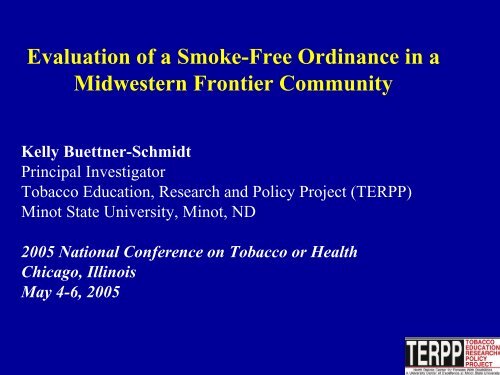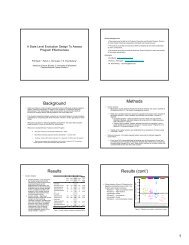Evaluation of a Smoke-Free Ordinance in a Midwestern Frontier ...
Evaluation of a Smoke-Free Ordinance in a Midwestern Frontier ...
Evaluation of a Smoke-Free Ordinance in a Midwestern Frontier ...
Create successful ePaper yourself
Turn your PDF publications into a flip-book with our unique Google optimized e-Paper software.
<strong>Evaluation</strong> <strong>of</strong> a <strong>Smoke</strong>-<strong>Free</strong> <strong>Ord<strong>in</strong>ance</strong> <strong>in</strong> a<br />
<strong>Midwestern</strong> <strong>Frontier</strong> Community<br />
Kelly Buettner-Schmidt<br />
Pr<strong>in</strong>cipal Investigator<br />
Tobacco Education, Research and Policy Project (TERPP)<br />
M<strong>in</strong>ot State University, M<strong>in</strong>ot, ND<br />
2005 National Conference on Tobacco or Health<br />
Chicago, Ill<strong>in</strong>ois<br />
May 4-6, 2005
Presentation Content<br />
1. Synopsis <strong>of</strong> “Why Not M<strong>in</strong>ot: The Battle Over<br />
North Dakota’s First <strong>Smoke</strong>-<strong>Free</strong> <strong>Ord<strong>in</strong>ance</strong>”<br />
2. Assessment <strong>of</strong> the <strong>Ord<strong>in</strong>ance</strong>:<br />
• Voter Satisfaction<br />
• Compliance<br />
• Economic Impact<br />
• Anecdotal Comments
Learner Outcome<br />
• Assess and describe:<br />
– the economic impact,<br />
– voter support and<br />
– compliance <strong>of</strong> a smoke-free ord<strong>in</strong>ance <strong>in</strong> a<br />
<strong>Midwestern</strong> frontier community.
Synopsis <strong>of</strong> “The Battle”<br />
• Lay<strong>in</strong>g the Groundwork<br />
• Passage at City Council<br />
• W<strong>in</strong>n<strong>in</strong>g the Opposition Led Referendum<br />
• Battl<strong>in</strong>g ongo<strong>in</strong>g exemption efforts<br />
• Implementation/Enforcement<br />
• <strong>Evaluation</strong>
An Assessment <strong>of</strong><br />
Voter Satisfaction with M<strong>in</strong>ot’s <strong>Smoke</strong>-<strong>Free</strong><br />
Restaurant <strong>Ord<strong>in</strong>ance</strong><br />
403 Voters<br />
October 28-30, 2003
Methodology<br />
• 403 random telephone <strong>in</strong>terviews among M<strong>in</strong>ot, North<br />
Dakota voters who voted <strong>in</strong> the most recent general<br />
election, November 2002<br />
• The results are weighted by age to more accurately reflect<br />
the electorate <strong>in</strong> M<strong>in</strong>ot, North Dakota<br />
• Interviews were conducted from October 28-30, 2003.<br />
• A random sample <strong>of</strong> 403 has a worst-case 95% confidence<br />
<strong>in</strong>terval <strong>of</strong> plus or m<strong>in</strong>us 4.9% about any one reported<br />
percentage<br />
• Survey conducted on behalf <strong>of</strong> M<strong>in</strong>ot State University by<br />
Harstad Strategic Research
As you may know, a law went <strong>in</strong>to effect <strong>in</strong> January 2002<br />
prohibit<strong>in</strong>g smok<strong>in</strong>g <strong>in</strong>side restaurants <strong>in</strong> M<strong>in</strong>ot. Now that this<br />
law has been <strong>in</strong> effect for nearly two years, is it someth<strong>in</strong>g you<br />
support or oppose?<br />
Oppose<br />
17%<br />
Somewhat<br />
Oppose<br />
Somewhat Support<br />
Strongly Oppose<br />
11%<br />
6%<br />
14%<br />
Don’t Know<br />
66%<br />
Strongly<br />
Support<br />
Support<br />
80%<br />
Support among key groups<br />
Non-smokers: 82%<br />
<strong>Smoke</strong>rs: 65%<br />
Men: 75%<br />
Women: 86%
How much <strong>of</strong> a health hazard is exposure to secondhand<br />
cigarette smoke?<br />
Don’t Know<br />
Not a health hazard at all<br />
M<strong>in</strong>or health hazard 5%<br />
11%<br />
Serious +<br />
Moderate<br />
Health Hazard<br />
82%<br />
Moderate health<br />
hazard<br />
23%<br />
59%<br />
Serious health hazard
M<strong>in</strong>ot Voters Agree That Restaurants Are Healthier & More<br />
Enjoyable Now That They Are <strong>Smoke</strong> <strong>Free</strong><br />
Percent who agree with each statement<br />
Strongly agree<br />
Somewhat agree<br />
Disagree<br />
M<strong>in</strong>ot restaurants are<br />
healthier for customers<br />
and employees s<strong>in</strong>ce the<br />
smoke-free ord<strong>in</strong>ance<br />
went <strong>in</strong>to effect<br />
68%<br />
20%<br />
88%<br />
8%<br />
It is more enjoyable to<br />
go out to M<strong>in</strong>ot<br />
restaurants now that they<br />
are smoke free<br />
68%<br />
12%<br />
80%<br />
12%
M<strong>in</strong>ot Voters Believe The Rights <strong>of</strong> Customers & Employees<br />
Are More Important Than The Rights <strong>of</strong> <strong>Smoke</strong>rs<br />
Please tell me which statement is more important:<br />
The rights <strong>of</strong> customers and employees to breathe clean air <strong>in</strong>side restaurants<br />
The rights <strong>of</strong> smokers to smoke <strong>in</strong>side restaurants<br />
The rights <strong>of</strong> smokers<br />
to smoke<br />
Neither<br />
Both<br />
3%<br />
4%<br />
Don’t Know<br />
13%<br />
78%<br />
The rights <strong>of</strong> customer<br />
and employees to<br />
breathe clean air
M<strong>in</strong>ot Voters Believe Peoples’ Right to Breathe Clean<br />
Air Outweighs Bus<strong>in</strong>ess Owners’ Right to Choose<br />
Please tell me which statement is closer to your view:<br />
Bus<strong>in</strong>ess owners should have a right to decide if smok<strong>in</strong>g is allowed<br />
or prohibited <strong>in</strong> their establishments, so we should not have laws that<br />
prohibit smok<strong>in</strong>g <strong>in</strong>side workplaces, <strong>in</strong>clud<strong>in</strong>g restaurants.<br />
People have a right to breathe clean air <strong>in</strong> restaurants and at work, so<br />
we should have laws that prohibit smok<strong>in</strong>g <strong>in</strong>side workplaces, <strong>in</strong>clud<strong>in</strong>g<br />
restaurants.<br />
Bus<strong>in</strong>ess owners<br />
should have a right<br />
to decide<br />
35% 61%<br />
People have a<br />
right to breathe<br />
clean air
Compliance <strong>of</strong> M<strong>in</strong>ot Restaurants<br />
with the <strong>Smoke</strong>-<strong>Free</strong> Restaurant <strong>Ord<strong>in</strong>ance</strong>
Methodology<br />
• Obta<strong>in</strong>ed a list<strong>in</strong>g <strong>of</strong> licensed “RE” restaurants with<strong>in</strong><br />
the City <strong>of</strong> M<strong>in</strong>ot from local public health<br />
environmental health division<br />
• 87 restaurants total<br />
– 5 were exempt<br />
– 1 unable to be <strong>in</strong>spected<br />
• 81 restaurants <strong>in</strong>spected between June and September<br />
2003.
Methodology<br />
• Visual assessment <strong>of</strong> each restaurant<br />
• This visual <strong>in</strong>spection did not <strong>in</strong>clude an assessment<br />
related to the separate ventilation requirements <strong>of</strong> the<br />
ord<strong>in</strong>ance<br />
• Only three restaurants without bars and six<br />
restaurants with attached bars implemented separate<br />
ventilation systems<br />
• Additionally, the M<strong>in</strong>ot Police Department was<br />
contacted to assess compliance issues determ<strong>in</strong>ed by<br />
the police department<br />
• .
Summary <strong>of</strong> F<strong>in</strong>d<strong>in</strong>gs<br />
• Overall compliance with the restaurant ord<strong>in</strong>ance was<br />
high at 96% compliance<br />
• 100% <strong>of</strong> the restaurants did not have anyone smok<strong>in</strong>g<br />
<strong>in</strong> the smoke-free areas<br />
• 100% <strong>of</strong> the restaurants had all the ashtrays removed<br />
from the smoke-free areas<br />
• The M<strong>in</strong>ot Police Department stated there have been<br />
no problems with restaurant compliance.
Economic Impact Study
Methodology<br />
• Objective data collected by the Office <strong>of</strong> the North<br />
Dakota Tax Commissioner<br />
– Numbers <strong>in</strong>clude all restaurant sales <strong>in</strong> M<strong>in</strong>ot, not<br />
just a sampl<strong>in</strong>g<br />
– Data collected consistently by an agency with no<br />
<strong>in</strong>terest <strong>in</strong> the effects <strong>of</strong> local policy on restaurant<br />
sales<br />
• Six years <strong>of</strong> data collected and analyzed; five years<br />
pre and one year post implementation <strong>of</strong> the<br />
ord<strong>in</strong>ance. Data collect from the first quarter <strong>of</strong> 1997<br />
through the fourth quarter <strong>of</strong> 2002<br />
– Adjusts for normal fluctuations <strong>in</strong> sales and any<br />
seasonal patterns
Methodology<br />
• Data analyzed us<strong>in</strong>g l<strong>in</strong>ear regression analysis<br />
• Restaurant sales were analyzed as a fraction <strong>of</strong> the<br />
total retail sales
Data<br />
2002:03<br />
0.12<br />
0.1<br />
0.08<br />
0.06<br />
0.04<br />
0.02<br />
0<br />
Restaurant Taxable Sales and Purchases /<br />
Total Taxable Sales and Purchases (F)<br />
Fitted<br />
1999:01<br />
1999:03<br />
2000:01<br />
2000:03<br />
2001:01<br />
2001:03<br />
2002:01<br />
1998:03<br />
1998:01<br />
1997:03<br />
1997:01
Results<br />
• “The implementation <strong>of</strong> the smoke-free ord<strong>in</strong>ance<br />
had no significant effect on the fraction <strong>of</strong> sales that<br />
went to restaurants <strong>in</strong> M<strong>in</strong>ot.”<br />
• The results <strong>of</strong> the study showed the smoke-free<br />
ord<strong>in</strong>ance had no impact on restaurant sales for the<br />
City <strong>of</strong> M<strong>in</strong>ot.<br />
• “Analysis <strong>of</strong> six years <strong>of</strong> sales tax data shows that<br />
there was no economic effect <strong>of</strong> the smoke-free<br />
ord<strong>in</strong>ance on M<strong>in</strong>ot restaurants <strong>in</strong> spite <strong>of</strong> claims that<br />
the smoke-free ord<strong>in</strong>ance would hurt restaurant<br />
bus<strong>in</strong>ess.”
Support<strong>in</strong>g Anecdotal Evidence<br />
from the<br />
M<strong>in</strong>ot Bus<strong>in</strong>ess Community
Support<strong>in</strong>g Anecdotal Evidence<br />
• “…there seems to have been no negative effect on the<br />
convention <strong>in</strong>dustry <strong>in</strong> M<strong>in</strong>ot”and “…several (hotel<br />
and convention facility) managers felt that it has<br />
made a positive impact, even to the po<strong>in</strong>t <strong>of</strong> say<strong>in</strong>g<br />
that it has <strong>in</strong>creased their bus<strong>in</strong>ess.”<br />
– (March 7, 2005) Letter from Dusty Zimmerman,<br />
Director <strong>of</strong> Convention Sales, M<strong>in</strong>ot Convention<br />
and Visitors Bureau
Support<strong>in</strong>g Anecdotal Evidence<br />
• “…the <strong>in</strong>crease <strong>in</strong> bus<strong>in</strong>ess was noticeable.”<br />
• “Wait staff comments also were very favorable.”<br />
• “It’s proven to me that success <strong>in</strong> the restaurant<br />
bus<strong>in</strong>ess isn’t about smok<strong>in</strong>g or not smok<strong>in</strong>g, it’s<br />
about provid<strong>in</strong>g high-quality food and high-quality<br />
service on a consistent basis.”(March 14, 2005)<br />
– Dean Aberle, Owner <strong>of</strong> Homesteaders Restaurant.<br />
Written Testimony submitted to ND House Human<br />
Services Committee on Senate Bill 2300.
Support<strong>in</strong>g Anecdotal Evidence<br />
• “Kroll’s D<strong>in</strong>er owner Keith Glatt said a metrowide<br />
ban on smok<strong>in</strong>g <strong>in</strong> restaurants and bars makes the<br />
most sense so some bus<strong>in</strong>esses don’t have<br />
advantages. Kroll’s also has a restaurant <strong>in</strong> M<strong>in</strong>ot,<br />
N.D., where smok<strong>in</strong>g recently was banned, and Glatt<br />
said his sales have <strong>in</strong>creased 10 percent to 15<br />
percent.” (January 10, 2004) - The Fargo Forum<br />
• “Bus<strong>in</strong>ess has been better. We’ve only been smokefree<br />
for about a month, but the <strong>in</strong>crease <strong>in</strong> bus<strong>in</strong>ess is<br />
noticeable.”<br />
– (July, 2001) - Dean Aberle, Owner <strong>of</strong><br />
Homesteaders Restaurant
Summary<br />
<strong>Evaluation</strong> <strong>of</strong> the M<strong>in</strong>ot <strong>Smoke</strong>-<strong>Free</strong> <strong>Ord<strong>in</strong>ance</strong> found:<br />
1. High voter satisfaction<br />
2. High restaurant compliance<br />
3. Neutral economic impact
<strong>Evaluation</strong> <strong>of</strong> a <strong>Smoke</strong>-<strong>Free</strong> <strong>Ord<strong>in</strong>ance</strong> <strong>in</strong> a<br />
<strong>Midwestern</strong> <strong>Frontier</strong> Community<br />
Kelly Buettner-Schmidt<br />
Pr<strong>in</strong>cipal Investigator<br />
Tobacco Education, Research and Policy Project (TERPP)<br />
M<strong>in</strong>ot State University, M<strong>in</strong>ot, ND<br />
701-858-3256<br />
Kelly.Schmidt@m<strong>in</strong>otstateu.edu





